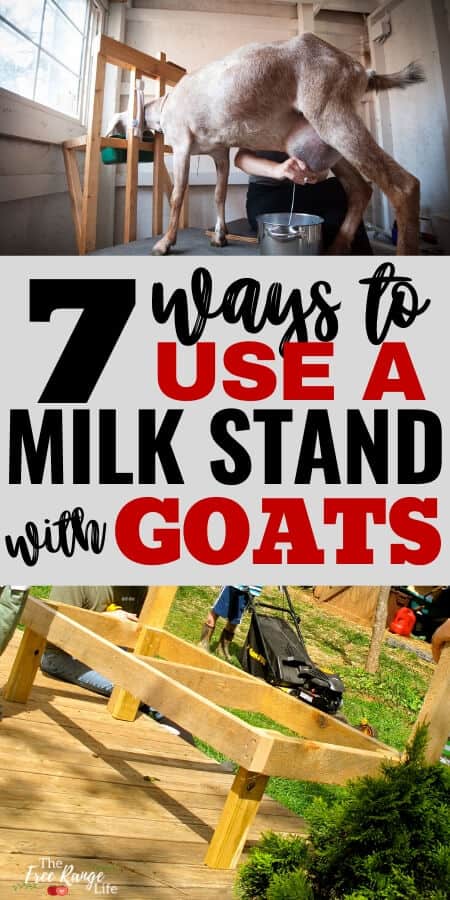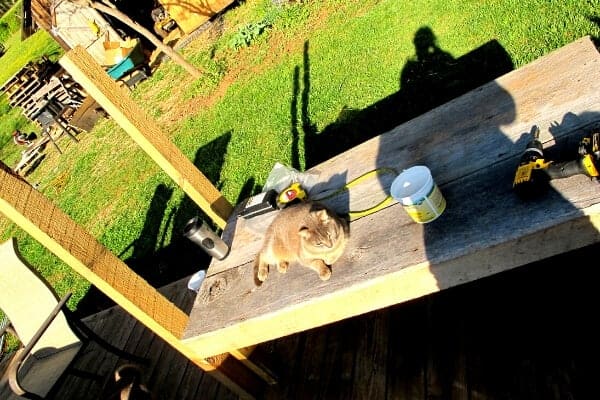Do you have a milk stand for your goats? Whether you raise goats for milk, meat, or pets, learn how to use a milk stand to help you care for your goats more easily.
I raised goats for about a year before we built our first milk stand.
This site contains affiliate links. If you make a purchase using one of these links, I may earn a commission. Please see my disclosure page for more information about cookies collected and our privacy policy.
Silly me thought I didn’t need one until our first kidding season rolled around and I was ready to milk!
But that’s just not true- thinking back I could have saved my self a lot of frustration over that first year by having a milk stand right from the start!
So what other ways are their to use a milk stand?? Well, here are just 7 of the ways I use mine!
7 Ways to Use a Milk Stand (Beyond Just Milking)
First, let’s talk about what a milk stand, or a milk stanchion, is. Simply put it’s a platform for the goat to stand on that also has a place to secure the goat’s head so that they can’t run away or escape.
There’s also usually a place to hang a feed bucket on the front so the goat can eat while they are on the stand.
Now that that’s out of the way, here’s how to use it:
1. Milking (of Course!)
Let’s start with the obvious. The number one use of a milk stand is, of course, for milking.
The goat stands on the platform, with their head secure, and eating feed or hay in front of them, while you milk.
The benefits of using a stand over alternatives such as a leash?
Well a milk stand keeps them secure. They can’t turn around, walk away, or jump. You are in control of the environment and the goat tends to stay calmer.
2. Hoof Trimming
Hoof trimming without a milk stand was torture for me and my first goats. Even if I had feed in front of them and used a leash, they still stomped and twisted and turned.
A milk stand keeps them standing and occupied, meaning I can trim in record time- which also reduces stress on the goats.
Even our “babies” (I say that in quotes, because they aren’t really babies anymore, but they sure act like it when they leave the herd and their mom!), who don’t know what I am doing back there and yell the whole time can be trimmed quickly and efficiently.
3. Administering a Copper Bolus
Some goat owners use a banana or a treat of some sort to administer semi-annual copper supplements, but I feel the most reliable way to give copper- and reduce chewing of the rods- is to use a copper bolus and a bolus gun.
This can be tough to do when the goat is not held in a stationary position.
Using a milk stand to give a copper bolus makes things so much easier. I can even do it with just me- no helper!
4. Giving Your Goats Injections
Giving injections to your goat can be kind of nerve-racking, especially if you are new to goats or livestock in general.
You can be filled with worries of doing it wrong or the goat making a sudden movement and you stabbing the needle into the wrong place.
Most of the time goats don’t notice the needle stick, but what they DO notice is being held still against their will.
A milk stand is a less stressful way of being held still. And when feed is given- they usually don’t even know they can’t get away.
So next time you have to give an injection, bring your goat to the stand, give them a handful of feed, and it will all be over in a matter of seconds with no sudden movements!
5. Drenching Medications
Just like with giving injections, in order to drench a goat usually has to be held still.
It can also be a 2 person job sometimes, depending on how much liquid you are giving and the personality of the goat.
A milk stand is a strong 2nd “person” that holds your goat still so you can get the drench into their mouth without them running away.
6. Everyday Feeding
If you have a smaller herd, a milk stanchion can also be used for everyday feeding of grain.
When it comes to goat nutrition, it’s important that each goat gets the appropriate amount. And I don’t know about your goats, but mine like to play musical feeders if they aren’t tied up!
We tie each of ours to a short lead before feeding to make sure they stay at their bucket, but you can also feed each one individually on the milk stand.
This is great for getting them used to a milk stand if they are a first time milker.
7. Checking Body Condition
Being aware of your goat’s condition is an important step of staying prepared and preventing illnesses.
Bring each goat, one at a time, to the milk stand once a week (or month) and give them a good once over.
Check if they are too fat or thing. Check their hooves. Check for anemia. Give any supplements they might need.
They can eat while you do this, so it’s no-stress for all.
Get the #1 goat management resource today! The Busy Homesteader’s Goat Management Binder has everything you need to make raising goats a breeze!
Milk Stand FAQ
How do I get my goat ON the stand?
Once a goat knows what the milk stand is, they will jump on with no problem, but when you are dealing with a young or new goat, it can take some coaxing.
You can pick the goat up and set her on the stand. Or you can use a feed scoop to lure her on.
You cal also build a ramp or steps leading up if you think your goat is adverse to jumping.
I will tell you that pulling doesn’t really do the trick- goats are stubborn!
But once your goat learns that stand is where they get food- it’s all good.
How can I train my goat to behave on the milk stand?
Not all goats are angels while they eat their feed on the stand. Sometimes there can be stomping or kicking. Some goats even try to lay down.
The key to training them to behave is persistence- and staying calm. No yelling or frustrated noises. Your goat will feel those and get more upset.
You may have to hold legs with a strong hand, or use a hobble, and sometimes having a second person at the goat’s head, talking to her and feeding leaves goes a long way at calming a goat down.
How do I train my goat to be okay with being milked?
The best way is to start early. The more you use a milk stand in day to day life, the more comfortable your goat will be with it. So bring her to the stand to feed often.
Also be sure to use the time on the stand to get her used to having her udder touched.
Check out this video from my sister site Raising Goats for Beginners to help a new milker get used to being touched.
Where do I get a milk stand?
You can either buy one premade or make your own.
Check out places like Valley Vet Supplies, EBAY, or ETSY if you want to buy, or check out some of the DIY plans below.
DIY Milk Stand Plans to Try
Milk stands are actually very simple to make. They don’t have to be pretty- just functional and get the job done.
We made ours out of scrap wood without a plan. We just looked at pictures online and it worked out just fine.
But if you want some plans, here are some free DIY Milk Stand Plans.
DIY Milk Stand (On the Cheap) from Flip Flop Barnyard
How to Build a Goat Milk Stand from The Prairie Homestead
A Simple Stanchion for Goats from Hobby Farms
Goat Milk Stand (with Printable Plans) from A Butterfly House
Build a Pallet Goat Stand from A Life of Heritage







I always read every blog you write. Very informative and clear. I learn something new each time. Thanks Sarah
indeed
Thanks!!!
Very helpful! I love your insights. Enjoying my new adventure as a goat person, would like for the experience to. translate over to the goats LOL